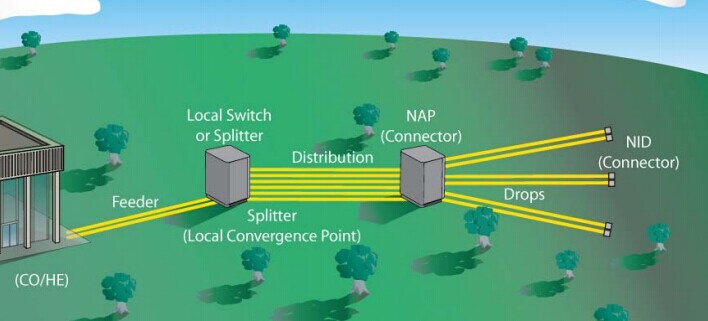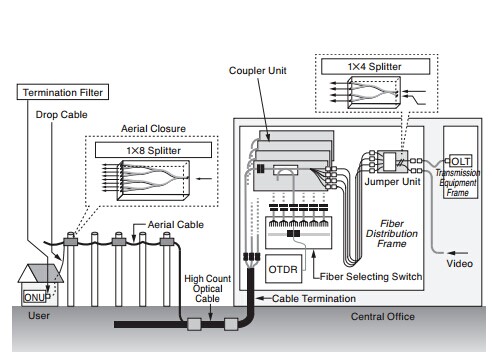Functions of various fiber optic splitter types are different. First, we’ll learn what is optical splitter.
Basic knowledge of Optical Splitter
Passive optical networks are characterized by the “splitting” of the optical fiber one or more times in the field, resulting in the sharing of the optical fiber amongst multiple users. The fiber in a PON is typically shared with 16 to 32 users. Hence the bandwidth of the fiber originating at the CO/HE is shared among a group of users. The splitting of the network is accomplished by an optical splitter. These splitters can split the fiber 2 to 32 times and, by their nature, introduce inherently high losses in the network. Therefore, their use is limited due to the power budget consideration of the network.
Increasing network reliability. A single 1 x 32 splitter has less loss than 1 x 2 and 1 x 16 or 1 x 4 fiber splitter and 1 x8 cascaded splitters or any combination of 1 x 16 or fiber splitter 1 x 4 and 1 x8 cascaded splitters in the network. With the evolution of optical networks, the need for multiple distributions of optical signals is crucial. For this application TELNET, S.A. offers its range of single mode and multimode fiber splitter. These couplers or splitters are used to split the input signal into N output branches with minimum loss.
Functions of Different Fiber Optic Splitter Types
PLC splitter
PLC splitter is one of fiber optic splitter types, and just its full name is planar lightwave circuit splitter, and it is made of silica optical waveguide technology. It has a good channel to channel uniformity, high reliability and small size which ranges of wide operating wavelength. and is widely used in PON networks to realize optical signal power management. And We Fiberstore provide a series of 1 x N and 2 x N splitters that all meet GR-1209-CORE and GR-1221-CORE and are certified by TLC for network development.
Fused Fiber Splitter
A fiber fused coupler is one of the most popular passive components for wavelength multi/demultiplexing or branching/combining of optical signal. They are used to split optical signals between two fibers, or to combine optical signals from two fibers into one fiber. Fused couplers do suffer from some disadvantage. Multimode fused couplers are mode dependent. Single fused couplers only transmit one mode, so they do not suffer from mode dependency. However, they are highly wavelength dependent. A difference in wavelength of which the fused fiber coupler will be used.
FS fused fiber couplers are available in a range of wavelengths, fiber sizes, and splitting ratios. Standards configurations are one by two and two by two couplers. N by M couplers, such as one by three, or one by four and so on are also available on request.
FTTH splitter
As for another passive optical splitter, FTTH splitter, these couplers/splitters are very often used in CATV networks. The Plastic splitter box is used for fiber cable and fiber communication equipment connection. It has redundant space for pigtails and adapters after up to 48 fusion splicing. Suitable for the ABS or LGX packed splitters to protect the connection between fiber cable and pigtails. Mainly for FTTH projects to be wall mount or rack mount fiber splitter, is realizing the function of fiber splitter, splicing, distribution and FTTH cable configuration.
conclusion
As mentioned above, different fiber optic splitter types have different functions. FS provides all the kinds of optical splitters, and they all meet the national standard of the optic network, and more than to say, It is doing big sales on many of their optical products.
Related Articles:
How Much Do You Know About PLC Splitter?
Differences Between FBT Splitter and PLC Splitter


